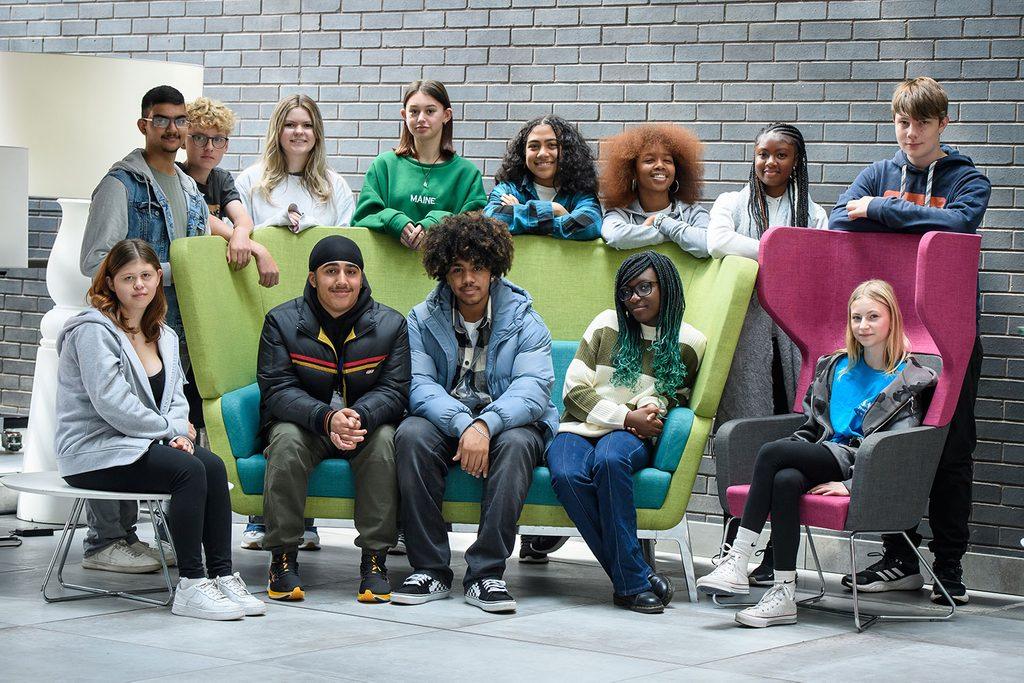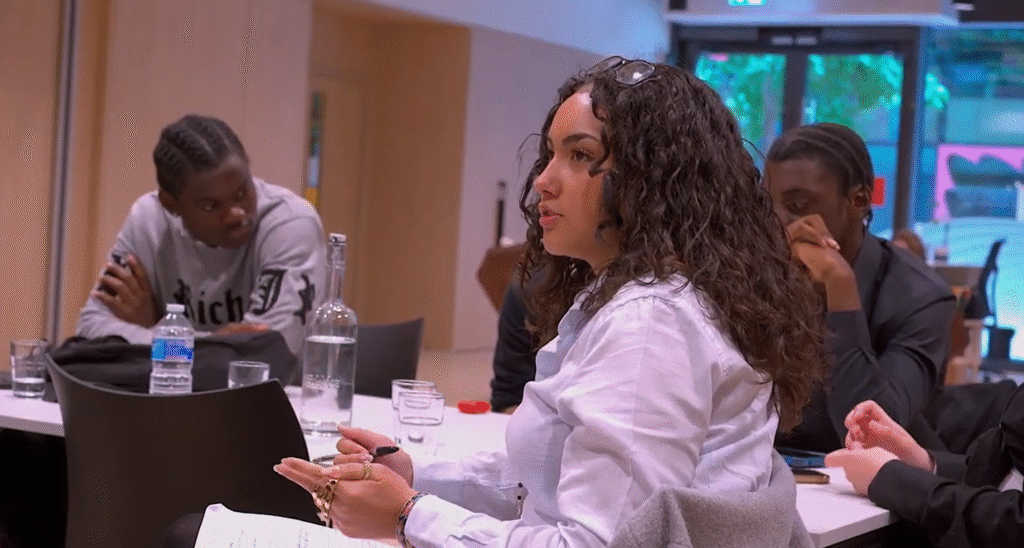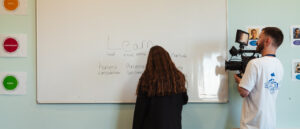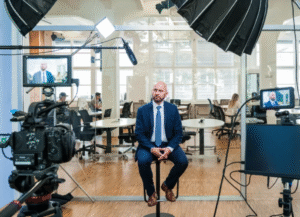Next step? Share your comms objectives and your long-term vision with our production team, and we’ll map a filming schedule that turns those raw moments into a year’s worth content to take your programme to the next level.
How Different Partners Benefit
1. Public Bodies & Councils
Problem: Community grants/foundations want measurable community impact/hard evidence. Annual reports are often text heavy with no human connection.
Solution: A journey film combines data and human stories from pupils, teachers and employers. Camden Learning used its film to secure an extra year of government backing—and is screening this film to student in secondary schools throughout the borough.
2. Corporate CSR & Early‑Careers Teams
Problem: Job ads and glossy careers brochures feel transactional. Candidates question whether diversity statements are genuine. CSR reports need stories that resonate with investors, stakeholders and young people.
Solution: Follow a group of interns as they tackle a real world business challenges, intercut senior leaders reactions. Short edits become LinkedIn proof‑points that diversity/employee engagements initiatives aren’t just words.
3. Course Providers & Bootcamps
Problem: Prospects sceptical about ‘job‑ready in 12-weeks’ claims. Written case studies lack engagement.
Solution: Film cohort progress sprints, first‑hire celebrations. Edit footage into micro‑lessons and victory stories for your internal communications platform and sales funnels and social media channels.
4. Alternative‑Education & Youth Charities
Problem: Leaders in education want and need to see under‑represented young people shine. Many not-for-profit/community orgs have limited marketing resources.
Solution: Document barriers (confidence, network gaps) and how mentorship dismantles them. Push monthly mini‑docs to viewers on social to raise awareness and keep donations flowing.
5. Universities & FE Colleges
Problem: Prospective students want real-world relevance, corporate partners seek visibility. Placements often go unnoticed by prospective students.
Solution: An episodic approach to documenting student reflections and progress enhances open‑day presentations and encourages corporate partnerships.
A tech giant we filmed gained a 40% increase in work experience applications after posting weekly clips documenting students stories on their Instagram account.
Let’s Turn Your Programme into Proof
Whether you’re a council focused on community engagement, a SaaS firm scaling early‑careers intake, an alterative education provider looking to scale/expand delivery, or an apprenticeship program promising job‑ready graduates, Fluent Media will work with you to engage different audience demographics in pursuit of the change you’re working towards.
Book a 30‑minute call and see how one shoot can fuel a year of persuasive content. Share your brief with us at info@fluentmedia.co.uk

- Map checkpoints – Sketch the arc before the cameras roll:
Day 1 (meet & greet, introductions to the program)
Mid-point (project hurdle, feedback loop)
Final day (deliverables, reflection)
+ 30-day and 6-month follow-ups, documenting long-term impact. - Identify the students/participants you want to feature.
Aim for a mix of backgrounds, confidence levels and career interests so viewers relate to what see they see on screen. Get parental/guardian consent early and brief them on the filming schedule. Pair each participant with a mentor buddy—to help them feel comfortable on camera. - Prep guiding questions.
Questions prepared in advance will help learner open up re. relatable fears, hidden motivations, expectations and aha moments. Print a one-pager to help mentors keep the tone conversational—spontaneous, unscripted anecdotes deliver the most impact. Draft 8–10 open prompts per checkpoint—e.g:
“What inspired you to join this program?” “What are you looking forward to most?” (Day 1),
“What new skills have you learned so far?” (mid-point),
“Who will you tell first about this weeks experience?” “What did you enjoy most?” (final day). - Capture dual perspectives.
For every learner interview, film a mentor, manager or council lead reacting to the same milestone. Intercutting the two views shows personal growth and organisational payoff. - Template motion graphics.
Agree on fonts, colour palette, lower-third layout and stat-call-out style once—then drop new clips in without reinventing the wheel. As over 70% of views on social are muted, adding captions to your reels and shorts, will help reinforce stats and key info, while maintaining brand‑consistency. Motion-graphics added during the post production help to amplify their words. - Plan the release calendar.
Treat content like an episodic series: daily 30-60s reels during the programme, a 3-5 min wrap film at the end, and monthly follow-ups that keep the story alive. Stagger platform posts (Instagram AM, LinkedIn PM) to maximise reach. Tie each release to real-world touchpoints, e.g. a follow-up reel the week apprenticeship applications open.
Next step? Share your comms objectives and your long-term vision with our production team, and we’ll map a filming schedule that turns those raw moments into a year’s worth content to take your programme to the next level.
How Different Partners Benefit
1. Public Bodies & Councils
Problem: Community grants/foundations want measurable community impact/hard evidence. Annual reports are often text heavy with no human connection.
Solution: A journey film combines data and human stories from pupils, teachers and employers. Camden Learning used its film to secure an extra year of government backing—and is screening this film to student in secondary schools throughout the borough.
2. Corporate CSR & Early‑Careers Teams
Problem: Job ads and glossy careers brochures feel transactional. Candidates question whether diversity statements are genuine. CSR reports need stories that resonate with investors, stakeholders and young people.
Solution: Follow a group of interns as they tackle a real world business challenges, intercut senior leaders reactions. Short edits become LinkedIn proof‑points that diversity/employee engagements initiatives aren’t just words.
3. Course Providers & Bootcamps
Problem: Prospects sceptical about ‘job‑ready in 12-weeks’ claims. Written case studies lack engagement.
Solution: Film cohort progress sprints, first‑hire celebrations. Edit footage into micro‑lessons and victory stories for your internal communications platform and sales funnels and social media channels.
4. Alternative‑Education & Youth Charities
Problem: Leaders in education want and need to see under‑represented young people shine. Many not-for-profit/community orgs have limited marketing resources.
Solution: Document barriers (confidence, network gaps) and how mentorship dismantles them. Push monthly mini‑docs to viewers on social to raise awareness and keep donations flowing.
5. Universities & FE Colleges
Problem: Prospective students want real-world relevance, corporate partners seek visibility. Placements often go unnoticed by prospective students.
Solution: An episodic approach to documenting student reflections and progress enhances open‑day presentations and encourages corporate partnerships.
A tech giant we filmed gained a 40% increase in work experience applications after posting weekly clips documenting students stories on their Instagram account.
Let’s Turn Your Programme into Proof
Whether you’re a council focused on community engagement, a SaaS firm scaling early‑careers intake, an alterative education provider looking to scale/expand delivery, or an apprenticeship program promising job‑ready graduates, Fluent Media will work with you to engage different audience demographics in pursuit of the change you’re working towards.
Book a 30‑minute call and see how one shoot can fuel a year of persuasive content. Share your brief with us at info@fluentmedia.co.uk

- Builds credibility – growth feels earned, not forced or manufactured. When the testimony feels natural, viewers trust narratives that shows struggle and progress.
- Soft skills come to life – confidence, teamwork ethic and curiosity are emotions to be captured. It’s difficult to convey a sense of progression or human connection in a written report.
- Keeps stakeholders engaged – an episodic approach results in an ongoing content supply, which can be repurposed for social media shorts, newsletters and internal comms announcements.
Dual‑Perspective Storytelling
Films that capture student progress work best when they track both sides of the exchange. Capturing two simultaneous arcs—learner discovery and insights from the employer, makes the stories more interesting and convincing.
In addition to the 8 min film above, we produced 2 shorter 3 min edits, the first designed to appeal to students, currently being shown in secondary schools throughout Camden to promote the 2025 initiative. The second film is being promoted to businesses in Camden, encouraging them to sign up to this and future work experience programmes.
Visit this page of our portfolio section to see the 2 shorter edits.
Testimony, straight from the rushes, that show how the exchange came alive.
| Learner Voices | Mentor / Employer Voices |
|---|---|
| “I don’t know if I’m 100 % confident about university yet. Looking at apprenticeship routes is helpful.” | “Google celebrates different backgrounds—remember this is your time; leave your mark.” — Google mentor |
| “I really enjoyed the soft skills—team-building and communication.” | “We want them inspired and motivated and to understand the pharmaceutical industry.” — AstraZeneca programme lead |
| “I need connections—that’s why I picked Google; there are doors everywhere.” | “Far too often we’re scared of failing. I encourage them to fail big.” — Keynote mentor |
| “I thought I didn’t belong in a place like this… now I know I do.” | “Do something you’ll build upon so they feel like part of a movement.” — British Land community manager |
| “We all worked so well together; the project wouldn’t have landed without the team.” | “Work experience builds personal and social capital; it changes long-term earnings.” — Camden Learning Chair |

Six Steps to Help You Document Learners Journeys, or Get Started with Fluent Media
- Map checkpoints – Sketch the arc before the cameras roll:
Day 1 (meet & greet, introductions to the program)
Mid-point (project hurdle, feedback loop)
Final day (deliverables, reflection)
+ 30-day and 6-month follow-ups, documenting long-term impact. - Identify the students/participants you want to feature.
Aim for a mix of backgrounds, confidence levels and career interests so viewers relate to what see they see on screen. Get parental/guardian consent early and brief them on the filming schedule. Pair each participant with a mentor buddy—to help them feel comfortable on camera. - Prep guiding questions.
Questions prepared in advance will help learner open up re. relatable fears, hidden motivations, expectations and aha moments. Print a one-pager to help mentors keep the tone conversational—spontaneous, unscripted anecdotes deliver the most impact. Draft 8–10 open prompts per checkpoint—e.g:
“What inspired you to join this program?” “What are you looking forward to most?” (Day 1),
“What new skills have you learned so far?” (mid-point),
“Who will you tell first about this weeks experience?” “What did you enjoy most?” (final day). - Capture dual perspectives.
For every learner interview, film a mentor, manager or council lead reacting to the same milestone. Intercutting the two views shows personal growth and organisational payoff. - Template motion graphics.
Agree on fonts, colour palette, lower-third layout and stat-call-out style once—then drop new clips in without reinventing the wheel. As over 70% of views on social are muted, adding captions to your reels and shorts, will help reinforce stats and key info, while maintaining brand‑consistency. Motion-graphics added during the post production help to amplify their words. - Plan the release calendar.
Treat content like an episodic series: daily 30-60s reels during the programme, a 3-5 min wrap film at the end, and monthly follow-ups that keep the story alive. Stagger platform posts (Instagram AM, LinkedIn PM) to maximise reach. Tie each release to real-world touchpoints, e.g. a follow-up reel the week apprenticeship applications open.
Next step? Share your comms objectives and your long-term vision with our production team, and we’ll map a filming schedule that turns those raw moments into a year’s worth content to take your programme to the next level.
How Different Partners Benefit
1. Public Bodies & Councils
Problem: Community grants/foundations want measurable community impact/hard evidence. Annual reports are often text heavy with no human connection.
Solution: A journey film combines data and human stories from pupils, teachers and employers. Camden Learning used its film to secure an extra year of government backing—and is screening this film to student in secondary schools throughout the borough.
2. Corporate CSR & Early‑Careers Teams
Problem: Job ads and glossy careers brochures feel transactional. Candidates question whether diversity statements are genuine. CSR reports need stories that resonate with investors, stakeholders and young people.
Solution: Follow a group of interns as they tackle a real world business challenges, intercut senior leaders reactions. Short edits become LinkedIn proof‑points that diversity/employee engagements initiatives aren’t just words.
3. Course Providers & Bootcamps
Problem: Prospects sceptical about ‘job‑ready in 12-weeks’ claims. Written case studies lack engagement.
Solution: Film cohort progress sprints, first‑hire celebrations. Edit footage into micro‑lessons and victory stories for your internal communications platform and sales funnels and social media channels.
4. Alternative‑Education & Youth Charities
Problem: Leaders in education want and need to see under‑represented young people shine. Many not-for-profit/community orgs have limited marketing resources.
Solution: Document barriers (confidence, network gaps) and how mentorship dismantles them. Push monthly mini‑docs to viewers on social to raise awareness and keep donations flowing.
5. Universities & FE Colleges
Problem: Prospective students want real-world relevance, corporate partners seek visibility. Placements often go unnoticed by prospective students.
Solution: An episodic approach to documenting student reflections and progress enhances open‑day presentations and encourages corporate partnerships.
A tech giant we filmed gained a 40% increase in work experience applications after posting weekly clips documenting students stories on their Instagram account.
Let’s Turn Your Programme into Proof
Whether you’re a council focused on community engagement, a SaaS firm scaling early‑careers intake, an alterative education provider looking to scale/expand delivery, or an apprenticeship program promising job‑ready graduates, Fluent Media will work with you to engage different audience demographics in pursuit of the change you’re working towards.
Book a 30‑minute call and see how one shoot can fuel a year of persuasive content. Share your brief with us at info@fluentmedia.co.uk

Neuroscience tells us that audiences remember stories as and when they see relatable characters evolve, far more than static slides full of ‘success stats’.
This question-led approach also shifts the spotlight from programme organisers to the learners themselves. Having a film crew on site sends a signal that their voices matter. Our work showed that through documenting change; it catalyses it, creating a sense of pride amongst students, allowing them to own their narrative, while serving funders and stakeholders a vivid, unforgettable proof of impact.
See other films produced for Camden Council/Google via this case study.
For educators and L&D leaders, this moving timeline does 3 things:
- Builds credibility – growth feels earned, not forced or manufactured. When the testimony feels natural, viewers trust narratives that shows struggle and progress.
- Soft skills come to life – confidence, teamwork ethic and curiosity are emotions to be captured. It’s difficult to convey a sense of progression or human connection in a written report.
- Keeps stakeholders engaged – an episodic approach results in an ongoing content supply, which can be repurposed for social media shorts, newsletters and internal comms announcements.
Dual‑Perspective Storytelling
Films that capture student progress work best when they track both sides of the exchange. Capturing two simultaneous arcs—learner discovery and insights from the employer, makes the stories more interesting and convincing.
In addition to the 8 min film above, we produced 2 shorter 3 min edits, the first designed to appeal to students, currently being shown in secondary schools throughout Camden to promote the 2025 initiative. The second film is being promoted to businesses in Camden, encouraging them to sign up to this and future work experience programmes.
Visit this page of our portfolio section to see the 2 shorter edits.
Testimony, straight from the rushes, that show how the exchange came alive.
| Learner Voices | Mentor / Employer Voices |
|---|---|
| “I don’t know if I’m 100 % confident about university yet. Looking at apprenticeship routes is helpful.” | “Google celebrates different backgrounds—remember this is your time; leave your mark.” — Google mentor |
| “I really enjoyed the soft skills—team-building and communication.” | “We want them inspired and motivated and to understand the pharmaceutical industry.” — AstraZeneca programme lead |
| “I need connections—that’s why I picked Google; there are doors everywhere.” | “Far too often we’re scared of failing. I encourage them to fail big.” — Keynote mentor |
| “I thought I didn’t belong in a place like this… now I know I do.” | “Do something you’ll build upon so they feel like part of a movement.” — British Land community manager |
| “We all worked so well together; the project wouldn’t have landed without the team.” | “Work experience builds personal and social capital; it changes long-term earnings.” — Camden Learning Chair |

Six Steps to Help You Document Learners Journeys, or Get Started with Fluent Media
- Map checkpoints – Sketch the arc before the cameras roll:
Day 1 (meet & greet, introductions to the program)
Mid-point (project hurdle, feedback loop)
Final day (deliverables, reflection)
+ 30-day and 6-month follow-ups, documenting long-term impact. - Identify the students/participants you want to feature.
Aim for a mix of backgrounds, confidence levels and career interests so viewers relate to what see they see on screen. Get parental/guardian consent early and brief them on the filming schedule. Pair each participant with a mentor buddy—to help them feel comfortable on camera. - Prep guiding questions.
Questions prepared in advance will help learner open up re. relatable fears, hidden motivations, expectations and aha moments. Print a one-pager to help mentors keep the tone conversational—spontaneous, unscripted anecdotes deliver the most impact. Draft 8–10 open prompts per checkpoint—e.g:
“What inspired you to join this program?” “What are you looking forward to most?” (Day 1),
“What new skills have you learned so far?” (mid-point),
“Who will you tell first about this weeks experience?” “What did you enjoy most?” (final day). - Capture dual perspectives.
For every learner interview, film a mentor, manager or council lead reacting to the same milestone. Intercutting the two views shows personal growth and organisational payoff. - Template motion graphics.
Agree on fonts, colour palette, lower-third layout and stat-call-out style once—then drop new clips in without reinventing the wheel. As over 70% of views on social are muted, adding captions to your reels and shorts, will help reinforce stats and key info, while maintaining brand‑consistency. Motion-graphics added during the post production help to amplify their words. - Plan the release calendar.
Treat content like an episodic series: daily 30-60s reels during the programme, a 3-5 min wrap film at the end, and monthly follow-ups that keep the story alive. Stagger platform posts (Instagram AM, LinkedIn PM) to maximise reach. Tie each release to real-world touchpoints, e.g. a follow-up reel the week apprenticeship applications open.
Next step? Share your comms objectives and your long-term vision with our production team, and we’ll map a filming schedule that turns those raw moments into a year’s worth content to take your programme to the next level.
How Different Partners Benefit
1. Public Bodies & Councils
Problem: Community grants/foundations want measurable community impact/hard evidence. Annual reports are often text heavy with no human connection.
Solution: A journey film combines data and human stories from pupils, teachers and employers. Camden Learning used its film to secure an extra year of government backing—and is screening this film to student in secondary schools throughout the borough.
2. Corporate CSR & Early‑Careers Teams
Problem: Job ads and glossy careers brochures feel transactional. Candidates question whether diversity statements are genuine. CSR reports need stories that resonate with investors, stakeholders and young people.
Solution: Follow a group of interns as they tackle a real world business challenges, intercut senior leaders reactions. Short edits become LinkedIn proof‑points that diversity/employee engagements initiatives aren’t just words.
3. Course Providers & Bootcamps
Problem: Prospects sceptical about ‘job‑ready in 12-weeks’ claims. Written case studies lack engagement.
Solution: Film cohort progress sprints, first‑hire celebrations. Edit footage into micro‑lessons and victory stories for your internal communications platform and sales funnels and social media channels.
4. Alternative‑Education & Youth Charities
Problem: Leaders in education want and need to see under‑represented young people shine. Many not-for-profit/community orgs have limited marketing resources.
Solution: Document barriers (confidence, network gaps) and how mentorship dismantles them. Push monthly mini‑docs to viewers on social to raise awareness and keep donations flowing.
5. Universities & FE Colleges
Problem: Prospective students want real-world relevance, corporate partners seek visibility. Placements often go unnoticed by prospective students.
Solution: An episodic approach to documenting student reflections and progress enhances open‑day presentations and encourages corporate partnerships.
A tech giant we filmed gained a 40% increase in work experience applications after posting weekly clips documenting students stories on their Instagram account.
Let’s Turn Your Programme into Proof
Whether you’re a council focused on community engagement, a SaaS firm scaling early‑careers intake, an alterative education provider looking to scale/expand delivery, or an apprenticeship program promising job‑ready graduates, Fluent Media will work with you to engage different audience demographics in pursuit of the change you’re working towards.
Book a 30‑minute call and see how one shoot can fuel a year of persuasive content. Share your brief with us at info@fluentmedia.co.uk

Running a mentoring, work-placement or any type of L&D programme focused on lasting change is challenging. The real test is in capturing personal stories and documenting an enduring narrative in a way that engages multiple stakeholders.
Trustees, funding partners and future participants.
When Camden Learning asked us to follow 16-18 year olds on a week‑long work‑experience sprint in 2024 featuring companies like Google, AstraZeneca and Digital Catapult, we knew a simple talking heads video filmed on a mobile phone wouldn’t cut it.
In order to capture the full array of emotions amongst the participants, we needed a plan to capture content throughout different stages of the process. The excitement, the nervousness and the lack of real-world-experience that is so common at the launch, through to the new found confidence and sense of accomplishment when they stand up on the final day to share their projects with mentors and peers.
The first step was to identify the students who showed the greatest potential for change/growth.
Thoughtful prompts invite young people to pause, name their feelings, and chart their own progress out loud. The act of verbalising, especially when they know the cameras are recording, turns private reflection into a shared milestone the audience can feel and empathise with. Each check-in layers a new brush-stroke onto the portrait: moments of self-doubt on day 1, students making friendships mid-week, peer recognition on presentation day.
Neuroscience tells us that audiences remember stories as and when they see relatable characters evolve, far more than static slides full of ‘success stats’.
This question-led approach also shifts the spotlight from programme organisers to the learners themselves. Having a film crew on site sends a signal that their voices matter. Our work showed that through documenting change; it catalyses it, creating a sense of pride amongst students, allowing them to own their narrative, while serving funders and stakeholders a vivid, unforgettable proof of impact.
See other films produced for Camden Council/Google via this case study.
For educators and L&D leaders, this moving timeline does 3 things:
- Builds credibility – growth feels earned, not forced or manufactured. When the testimony feels natural, viewers trust narratives that shows struggle and progress.
- Soft skills come to life – confidence, teamwork ethic and curiosity are emotions to be captured. It’s difficult to convey a sense of progression or human connection in a written report.
- Keeps stakeholders engaged – an episodic approach results in an ongoing content supply, which can be repurposed for social media shorts, newsletters and internal comms announcements.
Dual‑Perspective Storytelling
Films that capture student progress work best when they track both sides of the exchange. Capturing two simultaneous arcs—learner discovery and insights from the employer, makes the stories more interesting and convincing.
In addition to the 8 min film above, we produced 2 shorter 3 min edits, the first designed to appeal to students, currently being shown in secondary schools throughout Camden to promote the 2025 initiative. The second film is being promoted to businesses in Camden, encouraging them to sign up to this and future work experience programmes.
Visit this page of our portfolio section to see the 2 shorter edits.
Testimony, straight from the rushes, that show how the exchange came alive.
| Learner Voices | Mentor / Employer Voices |
|---|---|
| “I don’t know if I’m 100 % confident about university yet. Looking at apprenticeship routes is helpful.” | “Google celebrates different backgrounds—remember this is your time; leave your mark.” — Google mentor |
| “I really enjoyed the soft skills—team-building and communication.” | “We want them inspired and motivated and to understand the pharmaceutical industry.” — AstraZeneca programme lead |
| “I need connections—that’s why I picked Google; there are doors everywhere.” | “Far too often we’re scared of failing. I encourage them to fail big.” — Keynote mentor |
| “I thought I didn’t belong in a place like this… now I know I do.” | “Do something you’ll build upon so they feel like part of a movement.” — British Land community manager |
| “We all worked so well together; the project wouldn’t have landed without the team.” | “Work experience builds personal and social capital; it changes long-term earnings.” — Camden Learning Chair |

Six Steps to Help You Document Learners Journeys, or Get Started with Fluent Media
- Map checkpoints – Sketch the arc before the cameras roll:
Day 1 (meet & greet, introductions to the program)
Mid-point (project hurdle, feedback loop)
Final day (deliverables, reflection)
+ 30-day and 6-month follow-ups, documenting long-term impact. - Identify the students/participants you want to feature.
Aim for a mix of backgrounds, confidence levels and career interests so viewers relate to what see they see on screen. Get parental/guardian consent early and brief them on the filming schedule. Pair each participant with a mentor buddy—to help them feel comfortable on camera. - Prep guiding questions.
Questions prepared in advance will help learner open up re. relatable fears, hidden motivations, expectations and aha moments. Print a one-pager to help mentors keep the tone conversational—spontaneous, unscripted anecdotes deliver the most impact. Draft 8–10 open prompts per checkpoint—e.g:
“What inspired you to join this program?” “What are you looking forward to most?” (Day 1),
“What new skills have you learned so far?” (mid-point),
“Who will you tell first about this weeks experience?” “What did you enjoy most?” (final day). - Capture dual perspectives.
For every learner interview, film a mentor, manager or council lead reacting to the same milestone. Intercutting the two views shows personal growth and organisational payoff. - Template motion graphics.
Agree on fonts, colour palette, lower-third layout and stat-call-out style once—then drop new clips in without reinventing the wheel. As over 70% of views on social are muted, adding captions to your reels and shorts, will help reinforce stats and key info, while maintaining brand‑consistency. Motion-graphics added during the post production help to amplify their words. - Plan the release calendar.
Treat content like an episodic series: daily 30-60s reels during the programme, a 3-5 min wrap film at the end, and monthly follow-ups that keep the story alive. Stagger platform posts (Instagram AM, LinkedIn PM) to maximise reach. Tie each release to real-world touchpoints, e.g. a follow-up reel the week apprenticeship applications open.
Next step? Share your comms objectives and your long-term vision with our production team, and we’ll map a filming schedule that turns those raw moments into a year’s worth content to take your programme to the next level.
How Different Partners Benefit
1. Public Bodies & Councils
Problem: Community grants/foundations want measurable community impact/hard evidence. Annual reports are often text heavy with no human connection.
Solution: A journey film combines data and human stories from pupils, teachers and employers. Camden Learning used its film to secure an extra year of government backing—and is screening this film to student in secondary schools throughout the borough.
2. Corporate CSR & Early‑Careers Teams
Problem: Job ads and glossy careers brochures feel transactional. Candidates question whether diversity statements are genuine. CSR reports need stories that resonate with investors, stakeholders and young people.
Solution: Follow a group of interns as they tackle a real world business challenges, intercut senior leaders reactions. Short edits become LinkedIn proof‑points that diversity/employee engagements initiatives aren’t just words.
3. Course Providers & Bootcamps
Problem: Prospects sceptical about ‘job‑ready in 12-weeks’ claims. Written case studies lack engagement.
Solution: Film cohort progress sprints, first‑hire celebrations. Edit footage into micro‑lessons and victory stories for your internal communications platform and sales funnels and social media channels.
4. Alternative‑Education & Youth Charities
Problem: Leaders in education want and need to see under‑represented young people shine. Many not-for-profit/community orgs have limited marketing resources.
Solution: Document barriers (confidence, network gaps) and how mentorship dismantles them. Push monthly mini‑docs to viewers on social to raise awareness and keep donations flowing.
5. Universities & FE Colleges
Problem: Prospective students want real-world relevance, corporate partners seek visibility. Placements often go unnoticed by prospective students.
Solution: An episodic approach to documenting student reflections and progress enhances open‑day presentations and encourages corporate partnerships.
A tech giant we filmed gained a 40% increase in work experience applications after posting weekly clips documenting students stories on their Instagram account.
Let’s Turn Your Programme into Proof
Whether you’re a council focused on community engagement, a SaaS firm scaling early‑careers intake, an alterative education provider looking to scale/expand delivery, or an apprenticeship program promising job‑ready graduates, Fluent Media will work with you to engage different audience demographics in pursuit of the change you’re working towards.
Book a 30‑minute call and see how one shoot can fuel a year of persuasive content. Share your brief with us at info@fluentmedia.co.uk










